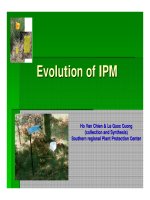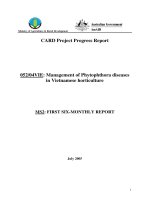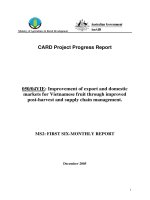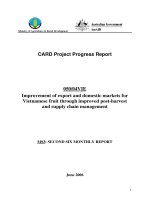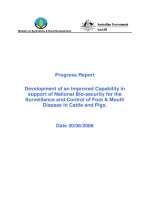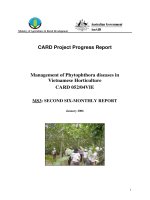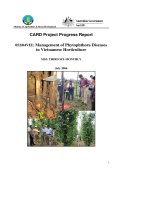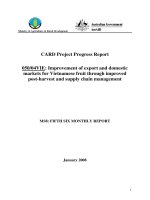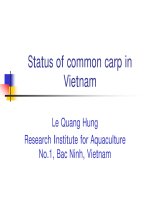Báo cáo nghiên cứu khoa học " Evolution of Evolution of IPM " pptx
Bạn đang xem bản rút gọn của tài liệu. Xem và tải ngay bản đầy đủ của tài liệu tại đây (17.43 MB, 54 trang )
Evolution of IPM
Evolution of IPM
Ho Van
Ho Van
Chien
Chien
& Le
& Le
Quoc
Quoc
Cuong
Cuong
(collection and Synthesis)
(collection and Synthesis)
Southern regional Plant Protection Center
Southern regional Plant Protection CenterWhat are pests?
What are pests?
Organisms that we believe reduce the value of
Organisms that we believe reduce the value of
resources that we are interested. They do this by
resources that we are interested. They do this by
causing loss in production and quality of food and
causing loss in production and quality of food and
fiber; by transmitting diseases; and reduce quality
fiber; by transmitting diseases; and reduce quality
of our environment.
of our environment.
Pest
Damage
Human values
Production
activities
Protection
activities
Pest
populations
Norton and Conway, 1977
Traditional pest control methods
Traditional pest control methods
Use of ants and PSO for
Use of ants and PSO for
fruit
fruit
-
-
orchards in China.
orchards in China.
Late sowing to control
Late sowing to control
white stem borers in
white stem borers in
Java.
Java.
Delay transplanting for
Delay transplanting for
yellow stem borer control
yellow stem borer control
in Japan.
in Japan.
Handpicking egg
Handpicking egg
masses.
masses.
Removing eggs using a
Removing eggs using a
rope soaked with
rope soaked with
kerosene
kerosene
Pesticide Era
Pesticide Era
Discovery of DDT (Muller 1939; Nobel Prize 1948)
Discovery of DDT (Muller 1939; Nobel Prize 1948)
Chlorinated compounds (BHC,
Chlorinated compounds (BHC,
dieldrin
dieldrin
,
,
endosulfan
endosulfan
)
)
Organophosphates/
Organophosphates/
Carbamates
Carbamates
(m
(m
-
-
parathion,
parathion,
carbofuran
carbofuran
)
)
Pyrethroids
Pyrethroids
(
(
deltamethrin
deltamethrin
)
)
Pesticide Era
Pesticide Era
•
•
R & D on chemical interventions dominated
R & D on chemical interventions dominated
agricultural change in developed countries in
agricultural change in developed countries in
1960
1960
’
’
s and 1970s and is still strongly influencing
s and 1970s and is still strongly influencing
pest management practices in most of Asia.
pest management practices in most of Asia.
•
•
Ecological understanding largely ignored or
Ecological understanding largely ignored or
superficially dealt with.
superficially dealt with.
•
•
Green Revolution
Green Revolution
-
-
Pesticides introduced as a necessary input and farmers
Pesticides introduced as a necessary input and farmers
encouraged to use them to achieve high yields through
encouraged to use them to achieve high yields through
advertising and loans.
advertising and loans.
Eg
Eg
.
.
Masagana
Masagana
99 (Philippines), BIMAS (Indonesia)
99 (Philippines), BIMAS (Indonesia)
Ecological and health concerns
Ecological and health concerns
Silent Spring Rachel Carson 1962
Silent Spring Rachel Carson 1962
Undesirable effects of pesticides
Undesirable effects of pesticides
Development of resistance
Development of resistance
Increased need to discover new chemicals
Increased need to discover new chemicals
Pollution
Pollution
–
–
Biomagnification
Biomagnification
Accumulation of residues up the food chain
Accumulation of residues up the food chain
Human health hazards
Human health hazards
Acute and chronic toxicities
Acute and chronic toxicities
Effects on non target organisms, like bees,
Effects on non target organisms, like bees,
wildlife
wildlife
Loss in biodiversity
Loss in biodiversity
Disrupt natural biological control mechanisms
Disrupt natural biological control mechanisms
Pest resurgence
Pest resurgence
Development of secondary pest outbreaks
Development of secondary pest outbreaks
Phases in agricultural production
Phases in agricultural production
and pest control practices
and pest control practices
Subsistence
Subsistence
Ecological
Ecological
Exploitation
Exploitation
Crisis
Crisis
Resistance
Resistance
Cocktails
Cocktails
Higher sprays
Higher sprays
freq. & volumes
freq. & volumes
Disaster
Disaster
Industry decline
Industry decline
Recovery
Recovery
Book Chapter
Book Chapter
Ecotoxicology
Ecotoxicology
:
:
Pesticides and Beneficial Organisms
Pesticides and Beneficial Organisms
Impact of Insecticides
Impact of Insecticides
on
on
Herbivore
Herbivore
-
-
Natural Enemy
Natural Enemy
Communities
Communities
in
in
Tropical Rice Ecosystems
Tropical Rice Ecosystems
K.L. Heong & K.G.
K.L. Heong & K.G.
Schoenly
Schoenly
1998
1998
Ecological and species concerns
Ecological and species concerns
Ecological disruptions that cause
Ecological disruptions that cause
Insect
Insect
-
-
pests and diseases
pests and diseases
problems
problems
Drought
Drought
Floods
Floods
Abnormal migrations
Abnormal migrations
Pesticides
Pesticides
Impact of insecticides on
Impact of insecticides on
predators
predators
The insecticide sprays
The insecticide sprays
in citrus orchards
in citrus orchards
cause of red
cause of red
-
-
mite
mite
resurgence and
resurgence and
population increase.
population increase.
Loss of natural enemy
Loss of natural enemy
components, could not
components, could not
weaver ant
weaver ant
-
-
keeping.
keeping.
Mean food chain lengths reduced
Mean food chain lengths reduced
Sprays reduced chain lengths
Sprays reduced chain lengths
significantly from 3 to about 2.
significantly from 3 to about 2.
Estimated time for food web to
Estimated time for food web to
recover was
recover was
22 days after the last spray.
22 days after the last spray.
Sprays bring about asynchrony in
Sprays bring about asynchrony in
predator
predator
-
-
prey relationships.
prey relationships.
The secondary pest becomes to
The secondary pest becomes to
major pest
major pest
Insecticide sprays, especially in the early
Insecticide sprays, especially in the early
crop stages, favor the development of
crop stages, favor the development of
secondary pests, like BPH in Rice or Red
secondary pests, like BPH in Rice or Red
mite in Citrus.
mite in Citrus.
Insecticides have differential effects on
Insecticides have differential effects on
guilds and community structure.
guilds and community structure.
The secondary pest has higher population
The secondary pest has higher population
growth rates than predators.
growth rates than predators.
Egg stage
Egg stage
–
–
refuge from
refuge from
pesticides or the secondary pest
pesticides or the secondary pest
resurgence
resurgence
Resurgence and secondary pest
Resurgence and secondary pest
o o o o o o
x x x x x
o o o o o o
x x x x x
o o o o o o
o o
x x
x
o o
x o x x x x
x x x x x
o o x x x x
x x x x x
x x x x o x
o o o o o o
x x x x x
o o o o o o
x x x x x
o o o o o o
o o
x x
o o
x
o
o o o o o o
o x o x o o
o o o o o o
o o x o o o o
o o o o o o
Pre treatment Shortly after treatment
Pest resurgence
Pre treatment Shortly after treatment
Outbreak of pest o
Semantics
Semantics
Integrated pest control
Integrated pest control
Smith, van den Bosch, Stern, FAO panel of
Smith, van den Bosch, Stern, FAO panel of
experts 1960s & 1970s
experts 1960s & 1970s
Pest management
Pest management
Clark,
Clark,
Geier
Geier
, Morris.1960s & 1970s
, Morris.1960s & 1970s
Integrated pest management
Integrated pest management
Bottrell
Bottrell
1979.
1979.
Now a widely adopted term.
Now a widely adopted term.
Definitions
Definitions
WWW site for IPM definitions.
WWW site for IPM definitions.
www.ippc.orst.edu
www.ippc.orst.edu
IPM is the selection, integration, and
IPM is the selection, integration, and
implementation of pest control based on
implementation of pest control based on
predicted economic, ecological, and
predicted economic, ecological, and
sociological consequences (
sociological consequences (
Bottrell
Bottrell
,
,
1979)
1979)
economic
ecological sociological
Economic Threshold Concept
Economic Threshold Concept
Economic injury level (EIL)
Economic injury level (EIL)
•
•
Pest level that will cause loss greater than
Pest level that will cause loss greater than
control cost
control cost
Crop loss cost > Control cost
Crop loss cost > Control cost
Economic threshold Level (ETL)
Economic threshold Level (ETL)
•
•
Pest level at which control should be taken to
Pest level at which control should be taken to
prevent pest from reaching EIL.
prevent pest from reaching EIL.
Control benefit = Control cost
Control benefit = Control cost
PDK
PDK
= C
= C
P = price of produce
P = price of produce
D = loss in yield per insect unit
D = loss in yield per insect unit
K = % reduction achieved by control
K = % reduction achieved by control
= pest level
= pest level
C = control cost.
C = control cost.
ETL
ETL
(
(
*) = C/
*) = C/
PDK
PDK
0
10
20
30
40
50
60
70
80
90
0
2
4
6
8
10
EIL
ETL
Threshold control
Threshold control
strategy rely on
strategy rely on
prior knowledge of pest population
prior knowledge of pest population
dynamics
dynamics
Pest A population
Pest A population
increases with time
increases with time
Expected benefits when
Expected benefits when
control is applied at 40
control is applied at 40
is large.
is large.
Pest B population
Pest B population
declines after first peak.
declines after first peak.
Expected benefits from
Expected benefits from
control is much
control is much
reduced.
reduced.
0
10
20
30
40
50
60
70
80
90
0 1 2 3 4 5 6 7 8 9 10 11
Pest A
Pest B
Economic threshold
Economic threshold
–
–
A trap?
A trap?
Assumes pesticide intervention is needed, ETL is to
Assumes pesticide intervention is needed, ETL is to
decide when?
decide when?
Assumes pest populations will increase if not treated.
Assumes pest populations will increase if not treated.
Assumes all variables in ETL, future development of
Assumes all variables in ETL, future development of
pest are known with certainty.
pest are known with certainty.
Assumes treatments will not harm natural biological
Assumes treatments will not harm natural biological
control or cause secondary pests.
control or cause secondary pests.
Assumes people will make decisions based on an
Assumes people will make decisions based on an
economic rationale.
economic rationale.
Assumes farmers
Assumes farmers
’
’
knowledge and beliefs are
knowledge and beliefs are
adequate and uniform.
adequate and uniform.
Action Threshold Level
Action Threshold Level
“
“
ATL
ATL
”
”
IPM becoming more farmer
IPM becoming more farmer
oriented
oriented
Farmer training using the FFS approach.
Farmer training using the FFS approach.
FAO Inter
FAO Inter
-
-
country program
country program
1.5 million farmers trained. Trained farmers reduce insecticide
1.5 million farmers trained. Trained farmers reduce insecticide
use.
use.
Knowledge, attitude and practice research.
Knowledge, attitude and practice research.
Conducted in 10 Asia countries
Conducted in 10 Asia countries
Farmer participatory research.
Farmer participatory research.
Carried out in 8 countries
Carried out in 8 countries
Strategic extension campaigns
Strategic extension campaigns
Used in several countries. Successful in weed management.
Used in several countries. Successful in weed management.
Multi stakeholder participation in the use of communication
Multi stakeholder participation in the use of communication
approaches
approaches
In Vietnam reduced insecticide use by 50% and 30% on citrus
In Vietnam reduced insecticide use by 50% and 30% on citrus
orchards
orchards
Initiated in Thailand in 2000.
Initiated in Thailand in 2000.
Understanding farmer decision making
Understanding farmer decision making
Behavioral decision model
Behavioral decision model
Stakeholders
Stakeholders
Farmers
NGOs
Extension Officers
Local government
officials
Researchers
Trainers
Scientists
Agricultural
technicians
Chemical
salespersons
Mass media
Education
systems
Neighbors
& communities
Religious
groups
P in IPM is more than pest
P in IPM is more than pest
Pests
Pests
Pesticides
Pesticides
Predators
Predators
People
People
Policies
Policies
Principles
Principles
Paradigms
Paradigms
Plant resistance
Plant resistance
Production practices
Production practices
IPM
IPM
Traditional Sequence
Traditional Sequence
in Research
in Research
Adapted from Bentley & Andrews (1995) KLH
Identify problems
Identify problems
Develop technologies
Develop technologies
Extend to farmers
Extend to farmers
